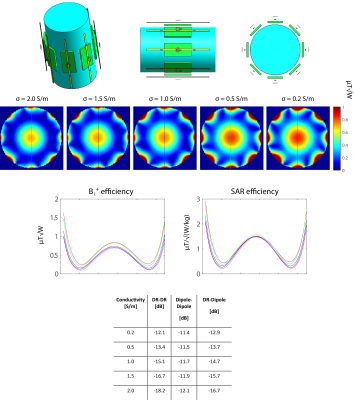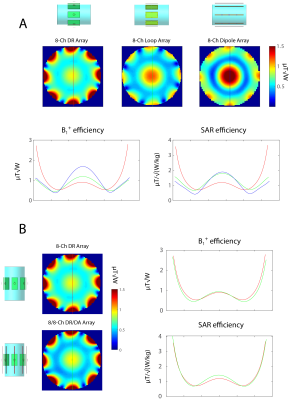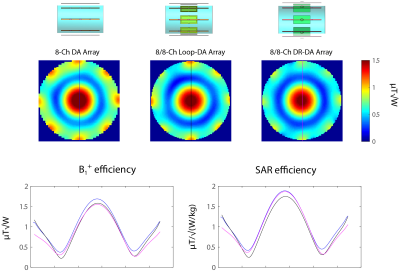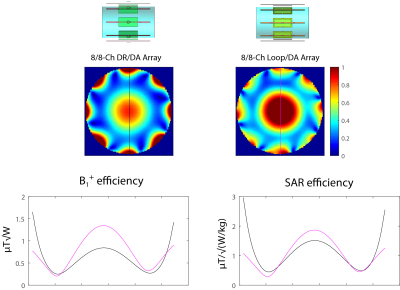4086
Dielectric Resonators and Dipole Antennas Combined: New Approach in Radio Frequency Coil Design for Ultrahigh Field MRI
Daniel Wenz1 and Rolf Gruetter1,2,3,4
1Center for Biomedical Imaging - Animal Imaging and Technology (CIBM-AIT), Ecole Polytechnique Fédérale de Lausanne (EPFL), Lausanne, Switzerland, 2Laboratory of Functional and Metabolic Imaging (LIFMET), Ecole Polytechnique Fédérale de Lausanne (EPFL), Lausanne, Switzerland, 3Department of Radiology, University of Lausanne, Lausanne, Switzerland, 4Department of Radiology, University of Geneva, Geneva, Switzerland
1Center for Biomedical Imaging - Animal Imaging and Technology (CIBM-AIT), Ecole Polytechnique Fédérale de Lausanne (EPFL), Lausanne, Switzerland, 2Laboratory of Functional and Metabolic Imaging (LIFMET), Ecole Polytechnique Fédérale de Lausanne (EPFL), Lausanne, Switzerland, 3Department of Radiology, University of Lausanne, Lausanne, Switzerland, 4Department of Radiology, University of Geneva, Geneva, Switzerland
Synopsis
Dielectric resonators (DR) can be advantageous over conventional loop elements, especially in ultrahigh field MRI. We noticed, that it is possible to combine DR in transverse electric mode with dipole antennas (DA), by placing them exactly above each other. In this study we explore the benefits of such combination in a multi-channel array configuration. We present the results of electromagnetic field simulations in which we compared an 8/8-channel DR-DA array with: 8-channel loop array, 8-channel DA array and 8/8-channel loop-DA array.
Introduction
Dielectric resonators (DR) are a promising alternative to conventional loop elements in radio frequency (RF) coil design for ultrahigh field (UHF) MRI1. Using DR, that have a very high dielectric permittivity, can provide higher magnetic field concentration closer to the resonator and reduced specific absorption rate (SAR) vs. a loop element of similar size2. Dipole antennas (DA) can provide higher transmit efficiency in deeper regions of human body3. We have noticed, that magnetic field vectors of DR in transverse electric (TE01δ) mode and DA are orthogonal to each other what results in particularly high level of isolation when one element is placed exactly above the other one. Consequently, DR and DA can be used as a building block of a multi-channel array that can benefit from all of the advantages of DR, DA and a combination of both (DR-DA). In this study, we have designed an 8/8-channel DR-DA array, performed electromagnetic field (EMF) simulations in cylindrical phantom, and benchmarked the 8/8-channel DR-DA array against: 8-channel loop array, 8-channel DA array and 8/8-channel loop/DA array.Methods
EMF and specific absorption rate (SAR) simulations in cylindrical phantom (radius = 75 mm, length = 250 mm, conductivity σ = 0.4 S/m, dielectric permittivity εr = 80) were performed using Sim4Life 4.4 (ZMT AG, Switzerland). The dielectric block has following electrical properties: σ = 0.2 S/m and εr = 1070. The size of the block is (90x44x5) mm3. The loop elements have the same size in plane as dielectric blocks and conductor width is 5 mm. The dipole antennas (total length = 210 mm) were fractionated using two inductors (60 nH). All of the arrays presented in this study were driven in circularly polarized (CP) mode (phase increment/element = 45°) and compared in terms of transmit field (B1+/√Pin) and SAR efficiency (B1+/√SAR10g). The 8/8-channel DR/DA array was driven in two different CP modes: only DR elements (TX-DR) and only DA elements were transmitting RF (TX-DA). TX-DR mode was compared with 8-channel DR array and 8-channel loop array. Finally, the 8/8-channel DR/DA was benchmarked against 8/8-channel loop/DA array.Results
Magnetic field (H-field) vectors of DR (TE01δ mode) and DA were orthogonal to each other (Figure 1). Reduced value of electrical conductivity in 8/8-channel DR/DA array, despite increased intra-element coupling, lead to significant gains in transmit and SAR efficiency, especially in surface regions (Figure 2). The 8/8-channel DR-DA array was tested in two different scenarios TX-DR and TX-DA. In TX-DR, B1+ and SAR efficiency of the 8/8-channel DR-DA array was significantly higher than an 8-channel loop array of similar size, up to the penetration depth of 4 cm (Figure 3). Placing DA elements over DR elements did not degrade the performance of 8-channel DR array. 8-channel DA array provided much higher transmit field efficiency in the center than 8-channel DR array and 8-channel loop array (Figure 3). In TX-DA, the 8/8-channel DR-DA array still provided very good B1+ in deeper regions: only 8% lower transmit efficiency than 8-channel DA array and 2% lower than 8/8 loop-DA array (Figure 4). The 8/8-channel DR/DA array performs better in surface regions in terms of B1+ efficiency than 8/8-channel DA/loop array (Figure 5), but was outperformed in deeper regions (loop element contribution).Discussion and Conclusion
Our simulations show that it is possible to combine dielectric resonators driven in TE01δ mode with dipole antennas. Placing both elements symmetrically above each other resulted in negligible coupling, because the EM fields produced by DA and DR were complementary. We showed, that B1+ efficiency of 8/8-channel DR-DA array, due to is duality, outperforms: 8-channel DR array in deeper regions, 8-channel loop array in surface (DR) and deeper (DA) regions, and 8-channel DA in surface regions. Moreover, 8/8-channel DR-DA array provides higher B1+ efficiency in surface regions than 8/8-channel loop/DA array, but lower B1+ efficiency in deeper regions. The latter can be easily explained, because in our proof-of-principle study we used DR of a very high εr. DR can be still optimized (geometry, σ, εr), so that it approaches loop performance in deeper regions. The possibility to optimize DR and combine it with DA might not only be relevant at 7.0 T, but also at higher field strengths (above 10.5 T), because the number of capacitors and inductors increases with resonance frequency, and DR elements do not require these components at all. In this work we focused on 8/8-channel array DR/DA, but our approach can be translated into other array configurations including lower and higher number of elements. We anticipate B1+ optimization in which DA could be used to further improve SAR efficiency. The expected gains in B1+ efficiency can not only advance state-of-the-art MR spectroscopy in surface regions of interest like cerebral cortex, muscle and skin, but also provide high B1+ efficiency in anatomical regions that are located deeper.Acknowledgements
No acknowledgement found.References
1. SA Aussenhofer, AG Webb, An eight-channel transmit/receive array of TE01 mode high permittivity ceramic resonators for human imaging at 7T, J Magn Reson, 2014 Jun; 243:122-9. 2. TPA OʼReilly, et al., Modular transmit/receive arrays using very-high permittivity dielectric resonator antennas. Magn Reson Med, 2018 Mar;79(3):1781-1788. 3. AJ Raaijmakers, et al., The fractionated dipole antenna: A new antenna for body imaging at 7 Tesla, Magn Reson Med, 2016 Mar;75(3):1366-74.Figures

Figure 1: Cylindrical phantom (σ=0.4 S/m, diameter = 75mm)
in axial view: H-field distribution. DR and DA H-fields are linearly polarized
and orthogonal to each other. The combination of both results in a circularly
polarized-like magnetic field.

Figure 2: Transmit field and SAR efficiency of
an 8/8-channel dielectric resonator-dipole array placed around a cylindrical
phantom as a function of varying electrical conductivity value (0.2, 0.5, 1.0,
1.5 and 2.0 S/m). B1+ shimming: phase increment = 45° per element. The table
below shows coupling between elements of 8/8-channel DR-DA array as a function
of DR conductivity. DR-DR – coupling between adjacent DR elements.
Dipole-Dipole – coupling between adjacent dipole elements. DR-Dipole – coupling
between adjacent DR and dipole elements.

Figure 3: (A) Transmit field and SAR efficiency
simulations: 8/8-channel DR-DA array (TX-DR) outperforms 8-ch loop array in
surface regions. 8-channel DA array provides the highest B1+
and SAR efficiency in the center of the phantom. (B) Using extra DA elements in
the 8/8-channel DR-DA array (TX-DR) does not lead to any performance
degradation with respect to 8-channel DR array.

Figure 4: Transmit field and SAR efficiency simulations:
8/8-channel DR-DA array (DA-TX) provides 8% lower B1+
efficiency than 8-channel DA array, and only 2% lower B1+
efficiency than 8/8-channel loop-DA array (only DA-elements TX active).

Figure 5: Comparison
of 8/8-channel DR/DA array and 8/8-channel loop/DA array. Very high DR dielectric
permittivity (εr = 1070) results in higher magnetic field
concentration in surface regions. Loop elements contribute to the higher transmit
efficiency in the center.